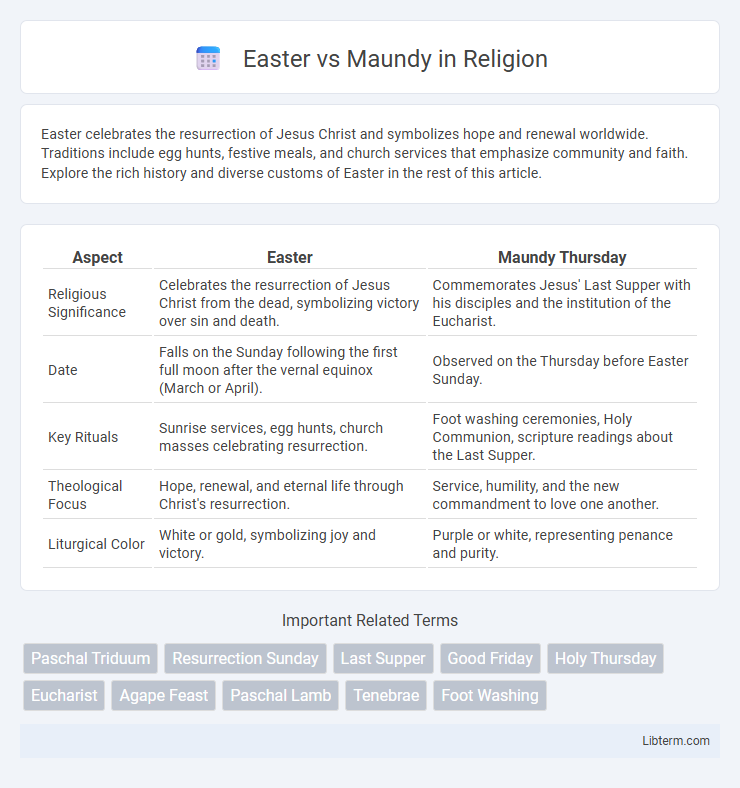Easter celebrates the resurrection of Jesus Christ and symbolizes hope and renewal worldwide. Traditions include egg hunts, festive meals, and church services that emphasize community and faith. Explore the rich history and diverse customs of Easter in the rest of this article.
Table of Comparison
| Aspect | Easter | Maundy Thursday |
|---|---|---|
| Religious Significance | Celebrates the resurrection of Jesus Christ from the dead, symbolizing victory over sin and death. | Commemorates Jesus' Last Supper with his disciples and the institution of the Eucharist. |
| Date | Falls on the Sunday following the first full moon after the vernal equinox (March or April). | Observed on the Thursday before Easter Sunday. |
| Key Rituals | Sunrise services, egg hunts, church masses celebrating resurrection. | Foot washing ceremonies, Holy Communion, scripture readings about the Last Supper. |
| Theological Focus | Hope, renewal, and eternal life through Christ's resurrection. | Service, humility, and the new commandment to love one another. |
| Liturgical Color | White or gold, symbolizing joy and victory. | Purple or white, representing penance and purity. |
Understanding the Origins of Easter and Maundy
Easter originates from the resurrection of Jesus Christ, celebrated as the cornerstone event in Christianity symbolizing victory over death and the promise of eternal life. Maundy Thursday commemorates the Last Supper, where Jesus instituted the Eucharist and commanded the act of washing disciples' feet, emphasizing humility and service. Both observances are integral to Holy Week, highlighting pivotal moments that define Christian faith and liturgical traditions.
Key Differences Between Easter and Maundy
Easter celebrates the resurrection of Jesus Christ from the dead, marking the cornerstone of Christian faith and occurring on the first Sunday after the first full moon following the vernal equinox. Maundy Thursday, also known as Holy Thursday, commemorates the Last Supper Jesus shared with his disciples, highlighting themes of service and humility through rituals like foot washing. While Easter emphasizes joy and new life, Maundy Thursday focuses on reflection, obedience, and preparation for the Passion of Christ.
The Religious Significance of Easter
Easter holds profound religious significance as it commemorates the resurrection of Jesus Christ from the dead, symbolizing victory over sin and eternal life for believers. It is the cornerstone of Christian faith, celebrated after Lent and Holy Week, contrasting with Maundy Thursday, which focuses on Jesus' Last Supper and the institution of the Eucharist. Easter's emphasis on resurrection highlights themes of hope, renewal, and divine salvation central to Christian doctrine.
The Historical Meaning of Maundy
Maundy Thursday commemorates the Last Supper of Jesus Christ with his disciples, highlighting the institution of the Eucharist and the commandment to love and serve others. Historically, Maundy emphasizes humility and self-sacrifice, reflecting Jesus' act of washing the feet of his disciples as a symbol of servant leadership. This day marks the beginning of the Passion, contrasting with Easter's celebration of the Resurrection and victory over death.
How Easter Is Celebrated Worldwide
Easter is celebrated worldwide through diverse traditions such as church services, festive meals, and symbolic activities like egg hunts and the Easter Bunny in Western cultures. In contrast, Maundy Thursday, observed primarily by Christian denominations, emphasizes solemn rituals including the washing of feet to commemorate Jesus' Last Supper. The global Easter celebration highlights themes of resurrection and renewal, with variations reflecting regional customs and religious significance.
Maundy Traditions and Practices
Maundy traditions center around the commemoration of Jesus Christ's Last Supper, commonly observed with the ritual washing of feet symbolizing humility and service. Clergy often distribute Maundy money or gifts to selected congregants, reflecting acts of charity and remembrance of Christ's mandate to love one another. These practices emphasize spiritual renewal and community care, distinct from the resurrection-focused celebrations of Easter.
Symbolism Associated with Easter and Maundy
Easter symbolizes resurrection and new life, represented by the empty tomb, eggs, and lilies, which emphasize renewal and hope. Maundy commemorates Jesus' Last Supper and the commandment of service, symbolized by foot washing and the sharing of bread and wine reflecting humility and community. Both observances highlight key Christian beliefs, with Easter focusing on victory over death and Maundy on servant leadership and covenant.
Easter vs Maundy: Rituals and Liturgies
Easter rituals center on the celebration of Jesus Christ's resurrection, featuring church services with joyful hymns, the lighting of the Paschal candle, and the Eucharist symbolizing new life. Maundy Thursday rituals commemorate the Last Supper, emphasizing humility and service through foot-washing ceremonies and the ritual of sharing bread and wine in the Holy Communion. The liturgies of Maundy Thursday are solemn and reflective, contrasting with Easter's jubilant and triumphant services that highlight victory over death.
The Role of Easter and Maundy in Christian Faith
Easter commemorates the resurrection of Jesus Christ, symbolizing victory over sin and the promise of eternal life, which serves as the cornerstone of Christian faith. Maundy, observed on Maundy Thursday, honors the Last Supper where Jesus instituted the Eucharist and exemplified servant leadership through the washing of disciples' feet. Together, these events emphasize the themes of sacrifice, redemption, and service central to Christian theology and worship practices.
Modern Interpretations of Easter and Maundy
Modern interpretations of Easter emphasize themes of renewal, hope, and spiritual rebirth, often celebrated through community gatherings, festive meals, and symbolic acts like egg decorating. Maundy Thursday, in contemporary contexts, highlights service, humility, and charity, reflecting Jesus' washing of the disciples' feet as an enduring call to compassion and social justice. Both observances continue to inspire personal reflection and communal bonding within diverse Christian traditions worldwide.
Easter Infographic

 libterm.com
libterm.com